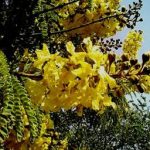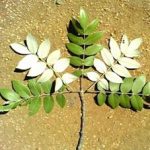TREE LIFE
May 2012
MASHONALAND CALENDAR
Sunday May 20th
Annual General Meeting of the Tree Society at the Education Centre, Mukuvisi Woodlands. We will meet at 09.30.am
Saturday May 26th
Garden of Peggy Sheppard of Crowhill. We will meet at 14.30. Peggy will kindly provide tea on her verandah.
REMINDER: TREE SOCIETY MEMBERSHIP
Membership for 2012 is due on April 1st. If you would like to vote at the AGM please pay your $5 subscription to Bill Clarke or Mark Hyde either before or at the meeting. Alternatively you can pay it into the Tree Society’s CABS account, quoting the members name as the reference. Account name: W.R. Clarke T/A Tree Society; Acc. No.: 9015224328.
REMINDER: Notice of the Annual General Meeting of the Tree Society
Notice is hereby given that the 62nd Annual General Meeting of the Tree Society of Zimbabwe will be held at the Education Centre, Mukuvisi Woodlands on Sunday 20th May 2012 at 9.30 am.
Any proposals/resolutions and nominations for office bearers (and any volunteers to be on the Committee) should be forwarded to the Acting Secretary Mark Hyde at mahyde@pentact.co.zw) by Sunday 6th May if possible, although proposals and nominations will be accepted from the floor.
AGENDA
- Notice convening the meeting.
- Apologies.
- Minutes of the 61st A.G.M.
- Matters Arising.
- Chairman’s Report.
- Treasurer’s Report.
- Election of Committee Members.
- Proposed amendments to the Constitution
- Any Other Business
BOOKS
Mark Hyde still has a number of Lyn Mullin’s excellent book “A New Zimbabwean Botanical Checklist” for sale ($5). Please contact him if you would like to buy one.
– Ed
TREE OF THE MONTH
Pseudolachnostylis maprouneifolia
Family: Euphorbiaceae. Common name: Duikerberry, Kuduberry Ndebele: Umqhombampunzi; Shona: Mudyamhembwe
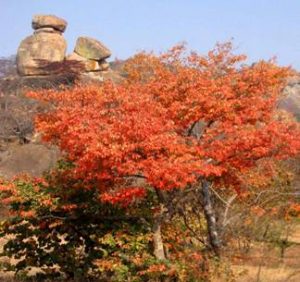
Pseudolachnostylis maprouneifolia in autumn
Pseudolachnostylis maprouneifolia, the Duiker or Kudu berry is another special tree. Although it is fairly widespread in Zimbabwe, it seems to be more prominent in Matabeleland where one can really enjoy the shade under its rounded fresh green canopy and, later in the year, its rich autumn colours as the chlorophyll pigments are withdrawn. It grows over a wide range of altitudes, in deciduous forest, in grassland and rocky outcrops, the last being its favourite and also where its colours can be best appreciated.
The tree has light grey to brown bark, a single main bole, simple, alternate round to ovate leaves and small greenish white flowers in axillary clusters.
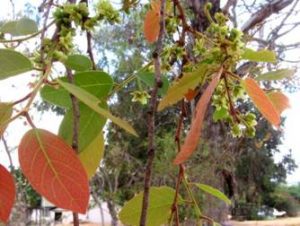
Pseudolachnostylis maprouneifolia showing autumn red leaves
The fruits are green, spherical, segmented with the flower styles persisting on the tips, occurring on female trees, the trees being dioecious. The fruit are very abundant but fall to the ground when still green. They are browsed by elephants and antelope, unfortunately they are not suitable for wine making.
The roots, the leaves and the bark are used medicinally. Once you have one of these trees you can as well throw your medicine chest away as they can be used for abdominal pains; as an aphrodisiac; against nausea; as an anthelmintic; for convulsions; bleeding; headache; gonorrhoeae; infertility; wounds; body weakness; dizziness and fever. I did not invent this, it come out of “The Traditional Medical Practitioner in Zimbabwe” by Michael Gelfand et al.
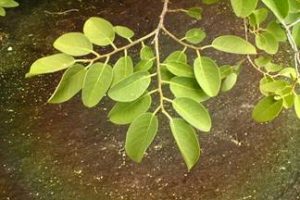
Pseudolachnostylis maprouneifolia leaves
The wood is quite useful, the sapwood and the heartwood being undifferentiated, the wood colour is nutbrown with a pink-mauve tinge. It can be used for furniture, carving and turning. It takes a nice polish after sanding.
-JP
TREE SOCIETY VISIT TO CATAPU, SOFALA, MOZAMBIQUE Friday, April 6th – Sunday, April 15th, 2012
Episode 1
About a year ago in April 2011, I had the pleasure of going on a choir tour of the UK with the Harare Male Voice and Phoenix choirs. That was their first tour outside Zimbabwe since they did a tour of South Africa over 40 years ago. Similarly, this is the first Tree Society outing held outside Zimbabwe for probably as many years.
What has driven and enabled this desire by two similar amateur societies to travel outside Zimbabwe’s borders? Perhaps one element is our relative freedom from exchange controls since dollarisation in 2009. In the case of this particular trip, an important factor was the knowledge and enthusiasm of one of our members, Meg Coates Palgrave and her long-standing interest in the Catapu area.
Plans were made at the end of 2011 and a pre-tour meeting was held in March at which Meg made a presentation about what we were likely to see and dealt with the practical aspects of money, travel and paperwork and specifically the important hurdle of crossing the border.
Right up to the last minute Meg’s attendance was in doubt as she was awaiting the return of her passport from a UK visa application. In the end she collected it at 3 pm on Thursday afternoon – about the last minute possible – and we were all good to go.
In total, 12 Tree Society members from Harare intrepidly made the 700 km journey from Harare; a further two came from Penhalonga and John Bennett travelled all the way from Lilongwe in Malawi, making a total of 15 in all.
Good Friday April 6th: The journey
Meg, Isla and I set out a day ahead of the rest. It was a long day of driving; at first along the relatively good roads in Zimbabwe to Mutare, where we filled up with fuel. Crossing the border proved straightforward and we were soon heading through Chimoio to Inchope.
There we turned left (North) onto the EN1 which takes us through Gorongosa and almost to Catapu itself. At this point the road deteriorates markedly and the next 20-30 km are marked by frequent enormous craters (too large to be called potholes) which entails weaving about all over the road.
The day itself was generally misty with low cloud and light rain and we saw little but the base of Gorongosa mountain. Although the EN1 had some good stretches, all too often they were succeeded by further areas of potholes and as night came on our progress got slower and slower. Eventually we reached Catapu at about 7 pm to a warm and friendly welcome from Ant White, Ivy and Clara. Ant is called James White in Mozambique because the Mozambicans have difficulty pronouncing the word ‘Ant’.
Our accommodation was at Mphingue Camp, about 1 km off the EN1, in comfortable wooden lodges. The site is on mains power which remained on throughout our trip – a delightful contrast to our lives in Zimbabwe.
To be continued……
-Mark Hyde


